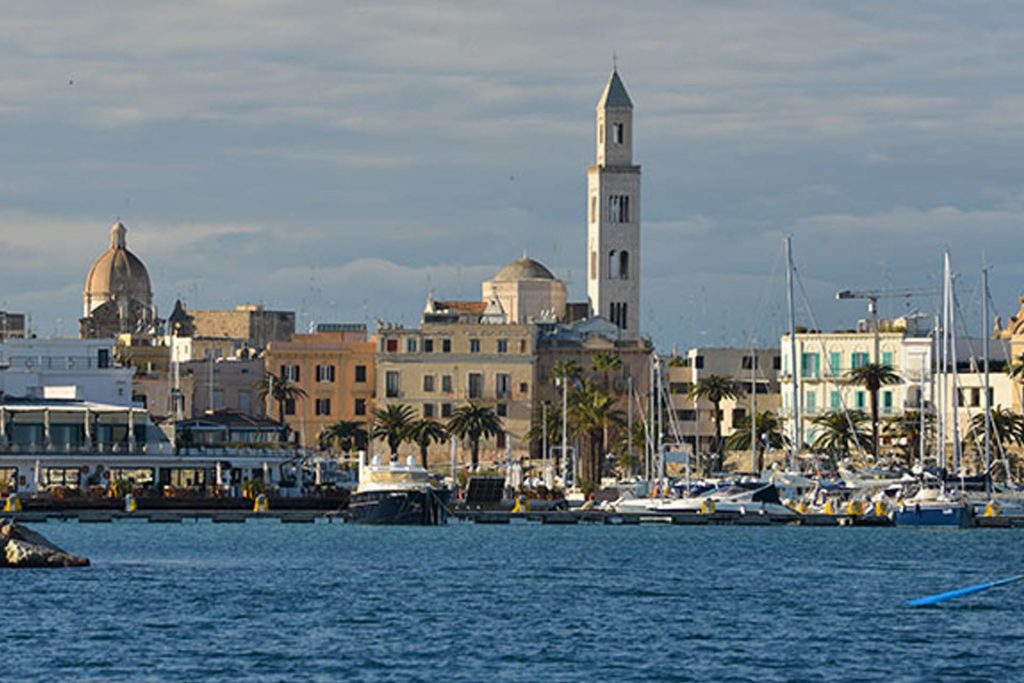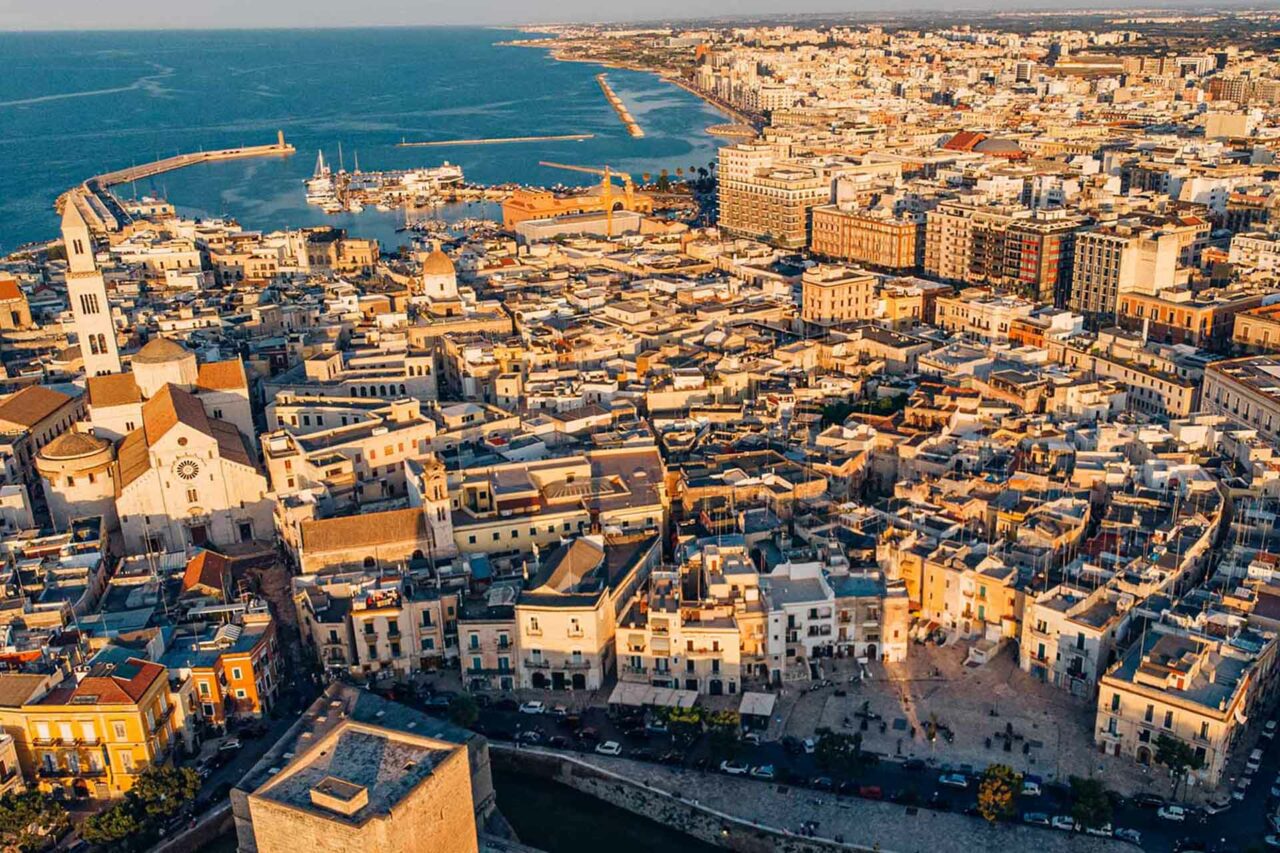Bari was called Bari delle Puglie until 1931. Today it is the capital of the metropolitan city of Bari and has over 300 thousand inhabitants.
Bari has a solid entrepreneurial and commercial tradition and has always been a focal point in the field of trade and political-cultural contacts with the Middle East (the so-called Levant). This has made it the largest Italian passenger port on the Adriatic Sea. Since 1930, the Fiera del Levante has been held in Bari, one of the main trade fairs in Italy.
The relics of St. Nicholas rest in the city’s cathedral. This has made Bari and its basilica one of the favorite centers of the Orthodox Church in the West and also an important center of interfaith communication between Orthodoxy and Catholicism.

The period of the foundation of Bari is uncertain. According to Pliny the Elder, but without any certain evidence, the then town was founded by Japige, son of Daedalus who came from Crete, and called Japigia, later conquered and enlarged by Captain Barione, a legendary Illyrian leader, and from him the current name.
It soon became the centre of Peucezia, an area which at that time largely corresponded to the Terra di Bari. It already had an intense maritime and commercial vocation.
In 326 BC Bari became a Roman municipium, because it was among the Apulian cities allied with Rome in the second Samnite war (moreover, in those years various Apulian tribes had asked the Romans for help against the nearby Samnites, who were increasingly threatening to encroach on the borders).
Latinizzata in Barivm (Barium), fu municipium cum suffragio, ebbe quindi la possibilità di darsi proprie leggi e istituzioni pur dipendendo da Roma.
Defended by walls and a fortress, from 108-110 AD Bari was crossed by the Via Appia Traiana, and had its own mint for minting coins, as well as a temple of Augustus and an older one dedicated to Apollo, and a pantheon for its pagan deities.
Few vestiges remain from the Roman period, just a few stretches of paving, some architectural or decorative elements often reused in medieval buildings, and structural bases or foundations found in the old city (Cathedral of San Sabino, Palazzo Simi).
With the fall of the Western Roman Empire in 476, it was invaded by the Barbarians and occupied by the Ostrogoths. It was taken from them by the Byzantines, during the Gothic War, and contested for the next two centuries by the Lombards of the Duchy of Benevento, who made it a gastald.
In 847 Bari fell into the hands of the Saracens. For about a quarter of a century it was the capital of a small independent Muslim state, with its own emir and mosque.
The first caliph of Bari was Khalfūn (847-852, a Berber leader of the Banu Rabi‘a tribe, who had been in Puglia for some time and probably came from Sicily.
After Khalfūn's death in 852, he was succeeded by the emir Mufarraj ibn Sallam, who consolidated the conquest, expanded its borders, and attempted to give it a legal basis according to Muslim public law.
The third and last emir of Bari, Sawdān, took power around 857, following the killing of Mufarraj. He invaded the lands of the Lombard duchy of Benevento and Duke Adelchi. The city was embellished with works and palaces, including a mosque, where Islam was practiced in its majority Sunni sense.
Conquered in 871 by the Holy Roman Emperor Louis II, Bari returned to the Byzantines in 876, becoming the major political, military and commercial centre of the Eastern Empire.
The city in fact became the capital of the theme of Longobardia, the seat of a strategos and, from 975, of the catapan, an imperial official who administered all the Byzantine domains in southern Italy. In this period Bari became the most important city and port in the region.
From the year 1000 the city suffered terrible attacks by the Saracens: the most serious of these occurred in the year 1002, a long siege from which Bari was liberated thanks to the intervention of the Venetian fleet, led by the doge Pietro II Orseolo. In gratitude the people of Bari built the church of San Marco dei Veneziani. Venetian merchants were numerous and in 1122 a trade treaty was signed between Bari and Venice.
Furthermore, there were numerous anti-Byzantine revolts, the most important of which was led by Melo (1009-1018), which spread to many cities in central-northern Puglia.
Byzantine rule ended in 1071, the year in which Robert Guiscard took power, beginning Norman rule. On May 9, 1087, the relics of Saint Nicholas, bishop of Myra, stolen by sailors from Bari, arrived in Bari.
In 1089, Abbot Elias began the construction of the Basilica of San Nicola, which was completed in 1097. Thus began the influx of pilgrims from all over the world.
Frederick II, despite his distrust of the people of Bari, who were considered restless and disloyal at the time, gave Bari the primacy of the region, and rebuilt the castle there, where he established one of the seven great fairs held in the kingdom of Sicily, and granted new privileges and trade.
Under Giovanna I the city was entangled in the struggles between the Angevins and the Durazzeschi, Ladislaus tried to revive it with some privileges, but Giovanna II made it a fief again in 1430.
Gioacchino Murat, in 1813, started a new urbanization, changing the face of the city and establishing a new checkerboard growth model, which continued for many years to come. The village built at the time at the gates of the old city, still retains its name.

 Orecchiette Pasta
Orecchiette Pasta


















Leave a comment